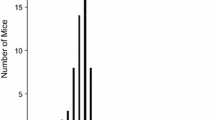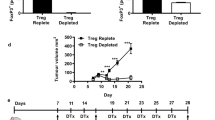Abstract
It is believed that primary tumor resection modulates host-tumor immune interaction, but this has not been characterized in a stringent breast cancer tumor model. This report, using the 4T1 murine mammary tumor model, characterizes for the first time the dynamic longitudinal changes in immunosuppressive and effector components of the immune system after resection of an established orthotopic primary tumor with a defined natural history of developing lung metastases. More specifically, we analyzed changes of absolute numbers and frequencies of MDSC, regulatory T cells (Treg), as well as activated CD4 and CD8 positive T cells in spleens and, in some studies, lungs of 4T1 tumor-bearing mice and mice after primary tumor resection. Importantly, using mathematical analyses we established that primary resection of an orthotopic tumor had created a “window of opportunity” with decreased tumor-associated immune suppression that existed for approximately 10 days. Although tumor resection did slightly prolong survival, it did not affect the ultimate development of metastatic disease since animals with resected tumors or intact primary tumors eventually died by day 47 and 43, respectively. This window of opportunity likely occurs in humans providing a rationale and parameters for integration and testing of immunotherapeutic strategies in this critical “window of opportunity” to combat the development of metastatic disease.







Similar content being viewed by others
Abbreviations
- MDSC:
-
Myeloid derived suppressor cells
- TAA:
-
Tumor associated antigen
- Treg:
-
Regulatory T cells
- TD:
-
Tumor diameter
- PMC:
-
Pulmonary mononuclear cells
- DC:
-
Dendritic cells
- TAM:
-
Tumor associated macrophages
References
American Cancer Society (2013) Cancer facts & figures
Hutchinson L, Kirk R (2011) New paradigms to explain metastasis. Nat Rev Clin Oncol 8(6):313
Rosenberg SA, Yang JC, Restifo NP (2004) Reply to “Cancer vaccines: pessimism in check”. Nat Med 10(12):1279–1280
Rosenberg SA, Yang JC, Restifo NP (2004) Cancer immunotherapy: moving beyond current vaccines. Nat Med 10(9):909–915
Tarhini AA (2013) Tremelimumab: a review of development to date in solid tumors. Immunotherapy 5(3):215–229
Sznol M, Chen L (2013) Antagonist antibodies to PD-1 and B7-H1 (PD-L1) in the treatment of advanced human cancer. Clin Cancer Res 19(5):1021–1034
Gabrilovich DI, Ostrand-Rosenberg S, Bronte V (2012) Coordinated regulation of myeloid cells by tumours. Nat Rev Immunol 12(4):253–268
Montero AJ, Diaz-Montero CM, Kyriakopoulos CE, Bronte V, Mandruzzato S (2012) Myeloid-derived suppressor cells in cancer patients: a clinical perspective. J Immunother 35(2):107–115
Bronte V, Mocellin S (2009) Suppressive influences in the immune response to cancer. J Immunother 32(1):1–11
Nagaraj S, Gabrilovich DI (2010) Myeloid-derived suppressor cells in human cancer. Cancer J 16(4):348–353
Ostrand-Rosenberg S (2010) Myeloid-derived suppressor cells: more mechanisms for inhibiting antitumor immunity. Cancer Immunol Immunother 59(10):1593–1600
Rudensky AY (2011) Regulatory T cells and Foxp3. Immunol Rev 241(1):260–268
Curiel TJ, Coukos G, Zou L, Alvarez X, Cheng P, Mottram P, Evdemon-Hogan M, Conejo-Garcia JR, Zhang L, Burow M, Zhu Y, Wei S, Kryczek I, Daniel B, Gordon A, Myers L, Lackner A, Disis ML, Knutson KL, Chen L, Zou W (2004) Specific recruitment of regulatory T cells in ovarian carcinoma fosters immune privilege and predicts reduced survival. Nat Med 10(9):942–949
Begley CG, Ellis LM (2012) Drug development: raise standards for preclinical cancer research. Nature 483(7391):531–533
Aslakson CJ, Miller FR (1992) Selective events in the metastatic process defined by analysis of the sequential dissemination of subpopulations of a mouse mammary tumor. Cancer Res 52(6):1399–1405
Heppner GH, Miller FR, Shekhar PM (2000) Nontransgenic models of breast cancer. Breast Cancer Res 2(5):331–334
Pulaski BA, Ostrand-Rosenberg S (2001) Mouse 4T1 breast tumor model. In: Coligan JE, Kruisbeek AM, Margulies DH, Shevach EM, Strober W (eds) Current protocols in immunology, vol 4. Wiley, New York
Pulaski BA, Terman DS, Khan S, Muller E, Ostrand-Rosenberg S (2000) Cooperativity of Staphylococcal aureus enterotoxin B superantigen, major histocompatibility complex class II, and CD80 for immunotherapy of advanced spontaneous metastases in a clinically relevant postoperative mouse breast cancer model. Cancer Res 60(10):2710–2715
Pulaski BA, Ostrand-Rosenberg S (1998) Reduction of established spontaneous mammary carcinoma metastases following immunotherapy with major histocompatibility complex class II and B7.1 cell-based tumor vaccines. Cancer Res 58(7):1486–1493
Bunt SK, Yang L, Sinha P, Clements VK, Leips J, Ostrand-Rosenberg S (2007) Reduced inflammation in the tumor microenvironment delays the accumulation of myeloid-derived suppressor cells and limits tumor progression. Cancer Res 67(20):10019–10026
Younos I, Donkor M, Hoke T, Dafferner A, Samson H, Westphal S, Talmadge J (2011) Tumor- and organ-dependent infiltration by myeloid-derived suppressor cells. Int Immunopharmacol 11(7):816–826
Chaput N, Darrasse-Jeze G, Bergot AS, Cordier C, Ngo-Abdalla S, Klatzmann D, Azogui O (2007) Regulatory T cells prevent CD8 T cell maturation by inhibiting CD4 Th cells at tumor sites. J Immunol 179(8):4969–4978
Darrasse-Jeze G, Bergot AS, Durgeau A, Billiard F, Salomon BL, Cohen JL, Bellier B, Podsypanina K, Klatzmann D (2009) Tumor emergence is sensed by self-specific CD44hi memory Tregs that create a dominant tolerogenic environment for tumors in mice. J Clin Invest 119(9):2648–2662
Danna EA, Sinha P, Gilbert M, Clements VK, Pulaski BA, Ostrand-Rosenberg S (2004) Surgical removal of primary tumor reverses tumor-induced immunosuppression despite the presence of metastatic disease. Cancer Res 64(6):2205–2211
Ruiterkamp J, Ernst MF (2011) The role of surgery in metastatic breast cancer. Eur J Cancer 47(Suppl 3):S6–S22
Kurosawa S, Kato M (2008) Anesthetics, immune cells, and immune responses. J Anesth 22(3):263–277
Vasilevko V, Ghochikyan A, Sadzikava N, Petrushina I, Tran M, Cohen EP, Kesslak PJ, Cribbs DH, Nicolson GL, Agadjanyan MG (2003) Immunization with a vaccine that combines the expression of MUC1 and B7 co-stimulatory molecules prolongs the survival of mice and delays the appearance of mouse mammary tumors. Clin Exp Metastasis 20(6):489–498
Loukinov D, Ghochikyan A, Mkrtichyan M, Ichim TE, Lobanenkov VV, Cribbs DH, Agadjanyan MG (2006) Antitumor efficacy of DNA vaccination to the epigenetically acting tumor promoting transcription factor BORIS and CD80 molecular adjuvant. J Cell Biochem 98(5):1037–1043
Mkrtichyan M, Ghochikyan A, Loukinov D, Davtyan H, Ichim TE, Cribbs DH, Lobanenkov VV, Agadjanyan MG (2008) DNA, but not protein vaccine based on mutated BORIS antigen significantly inhibits tumor growth and prolongs the survival of mice. Gene Ther 15(1):61–64
Monzavi-Karbassi B, Whitehead TL, Jousheghany F, Artaud C, Hennings L, Shaaf S, Slaughter A, Korourian S, Kelly T, Blaszczyk-Thurin M, Kieber-Emmons T (2005) Deficiency in surface expression of E-selectin ligand promotes lung colonization in a mouse model of breast cancer. Int J Cancer 117(3):398–408
Ziegler SF, Ramsdell F, Hjerrild KA, Armitage RJ, Grabstein KH, Hennen KB, Farrah T, Fanslow WC, Shevach EM, Alderson MR (1993) Molecular characterization of the early activation antigen CD69: a type II membrane glycoprotein related to a family of natural killer cell activation antigens. Eur J Immunol 23(7):1643–1648
Dexter DL, Kowalski HM, Blazar BA, Fligiel Z, Vogel R, Heppner GH (1978) Heterogeneity of tumor cells from a single mouse mammary tumor. Cancer Res 38:3174–3181
Miller BE, Miller FR, Leith J, Heppner GH (1980) Growth interaction in vivo between tumor subpopulations derived from a single mouse mammary tumor. Cancer Res 40(11):3977–3981
Lelekakis M, Moseley JM, Martin TJ, Hards D, Williams E, Ho P, Lowen D, Javni J, Miller FR, Slavin J, Anderson RL (1999) A novel orthotopic model of breast cancer metastasis to bone. Clin Exp Metastasis 17(2):163–170
Sinha P, Clements VK, Ostrand-Rosenberg S (2005) Reduction of myeloid-derived suppressor cells and induction of m1 macrophages facilitate the rejection of established metastatic disease. J Immunol 174(2):636–645
Olkhanud PB, Baatar D, Bodogai M, Hakim F, Gress R, Anderson RL, Deng J, Xu M, Briest S, Biragyn A (2009) Breast cancer lung metastasis requires expression of chemokine receptor CCR4 and regulatory T cells. Cancer Res 69(14):5996–6004
Youn JI, Nagaraj S, Collazo M, Gabrilovich DI (2008) Subsets of myeloid-derived suppressor cells in tumor-bearing mice. J Immunol 181(8):5791–5802
Melani C, Chiodoni C, Forni G, Colombo MP (2003) Myeloid cell expansion elicited by the progression of spontaneous mammary carcinomas in c-erbB-2 transgenic BALB/c mice suppresses immune reactivity. Blood 102(6):2138–2145
Diaz-Montero CM, Salem ML, Nishimura MI, Garrett-Mayer E, Cole DJ, Montero AJ (2009) Increased circulating myeloid-derived suppressor cells correlate with clinical cancer stage, metastatic tumor burden, and doxorubicin-cyclophosphamide chemotherapy. Cancer Immunol Immunother 58(1):49–59
Yu J, Du W, Yan F, Wang Y, Li H, Cao S, Yu W, Shen C, Liu J, Ren X (2013) Myeloid-derived suppressor cells suppress antitumor immune responses through IDO expression and correlate with lymph node metastasis in patients with breast cancer. J Immunol 190(7):3783–3797
Gabrilovich DI, Nagaraj S (2009) Myeloid-derived suppressor cells as regulators of the immune system. Nat Rev Immunol 9(3):162–174
Li Q, Pan PY, Gu P, Xu D, Chen SH (2004) Role of immature myeloid Gr-1+ cells in the development of antitumor immunity. Cancer Res 64(3):1130–1139
Narita Y, Wakita D, Ohkur T, Chamoto K, Nishimura T (2009) Potential differentiation of tumor bearing mouse CD11b+Gr-1+ immature myeloid cells into both suppressor macrophages and immunostimulatory dendritic cells. Biomed Res 30(1):7–15
Ostrand-Rosenberg S, Clements VK, Terabe M, Park JM, Berzofsky JA, Dissanayake SK (2002) Resistance to metastatic disease in STAT6-deficient mice requires hemopoietic and nonhemopoietic cells and is IFN-gamma dependent. J Immunol 169(10):5796–5804
Gonda K, Shibata M, Ohtake T, Yasuda M, Abe N, Watanabe K, Ando J, Okano M, Onozawa H, Tachibana K, Ohto H, Takenoshita S (2012) Myeloid-derived suppressor cells in patients with breast cancer. Gan To Kagaku Ryoho 39(9):1363–1368
Ohki S, Shibata M, Gonda K, Machida T, Shimura T, Nakamura I, Ohtake T, Koyama Y, Suzuki S, Ohto H, Takenoshita S (2012) Circulating myeloid-derived suppressor cells are increased and correlate to immune suppression, inflammation and hypoproteinemia in patients with cancer. Oncol Rep 28(2):453–458
Verma C, Eremin JM, Robins A, Bennett AJ, Cowley GP, El-Sheemy MA, Jibril JA, Eremin O (2013) Abnormal T regulatory cells (Tregs: FOXP3+, CTLA-4+), myeloid-derived suppressor cells (MDSCs: monocytic, granulocytic) and polarised T helper cell profiles (Th1, Th2, Th17) in women with large and locally advanced breast cancers undergoing neoadjuvant chemotherapy (NAC) and surgery: failure of abolition of abnormal treg profile with treatment and correlation of treg levels with pathological response to NAC. J Transl Med 11:16
Kimura T, McKolanis JR, Dzubinski LA, Islam K, Potter DM, Salazar AM, Schoen RE, Finn OJ (2013) MUC1 vaccine for individuals with advanced adenoma of the colon: a cancer immunoprevention feasibility study. Cancer Prev Res (Phila) 6(1):18–26
Acknowledgments
This work was supported by Susan Komen Foundation BCTR0707720 for E.L.N. and M.G.A., and in part by Award Number P30CA062203 from the National Cancer Institute. H.D. was supported by T32 training grant (AG000096) from the National Institute of Aging. We would like to thank Dr. Amanda Laust Anderson and Mr. Tigran Tiraturyan for help in some experimental procedures, Dr. Annette Marleau and Dr. Irina Petrushina for their valuable suggestions and editing of the manuscript.
Conflict of interest
Authors declare that they have no conflict of interests.
Author information
Authors and Affiliations
Corresponding authors
Additional information
Michael G. Agadjanyan and Anahit Ghochikyan contributed equally to this work.
Electronic supplementary material
Below is the link to the electronic supplementary material.
Rights and permissions
About this article
Cite this article
Ghochikyan, A., Davtyan, A., Hovakimyan, A. et al. Primary 4T1 tumor resection provides critical “window of opportunity” for immunotherapy. Clin Exp Metastasis 31, 185–198 (2014). https://doi.org/10.1007/s10585-013-9619-0
Received:
Accepted:
Published:
Issue Date:
DOI: https://doi.org/10.1007/s10585-013-9619-0




